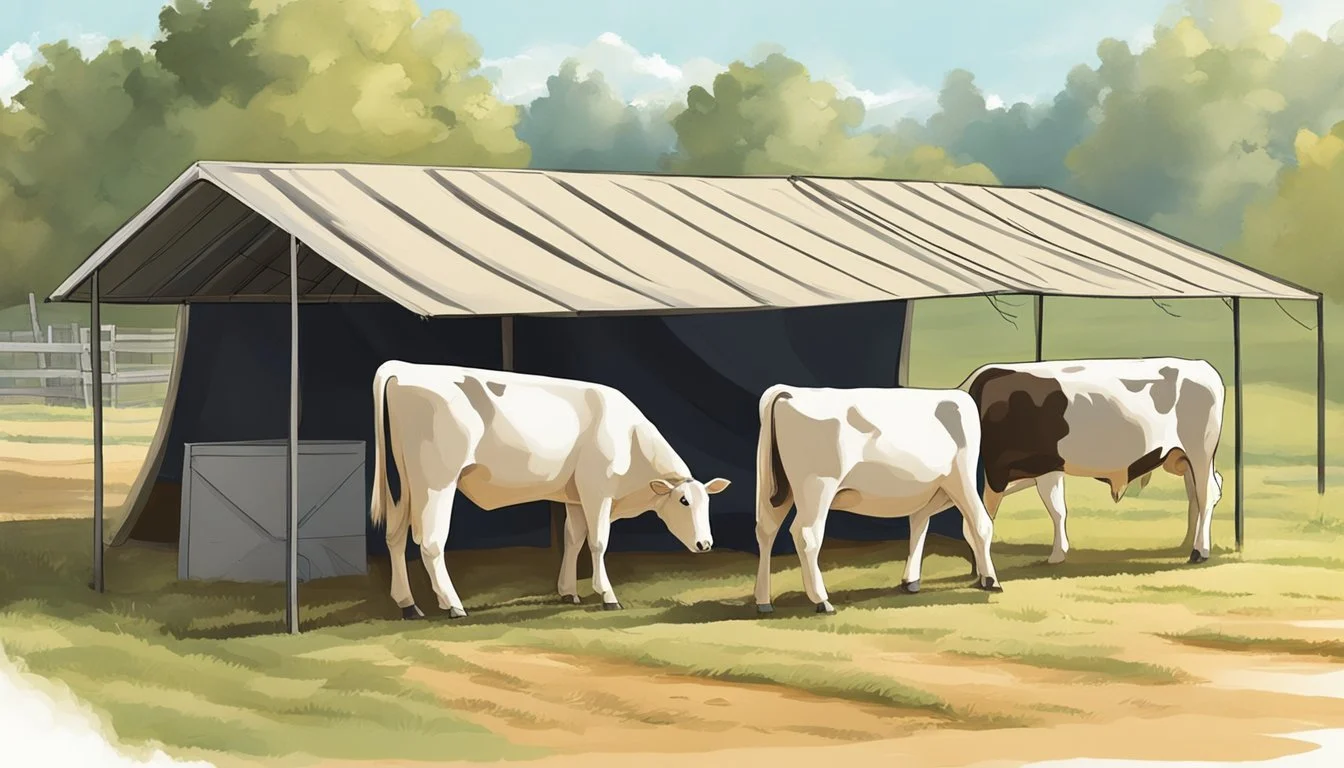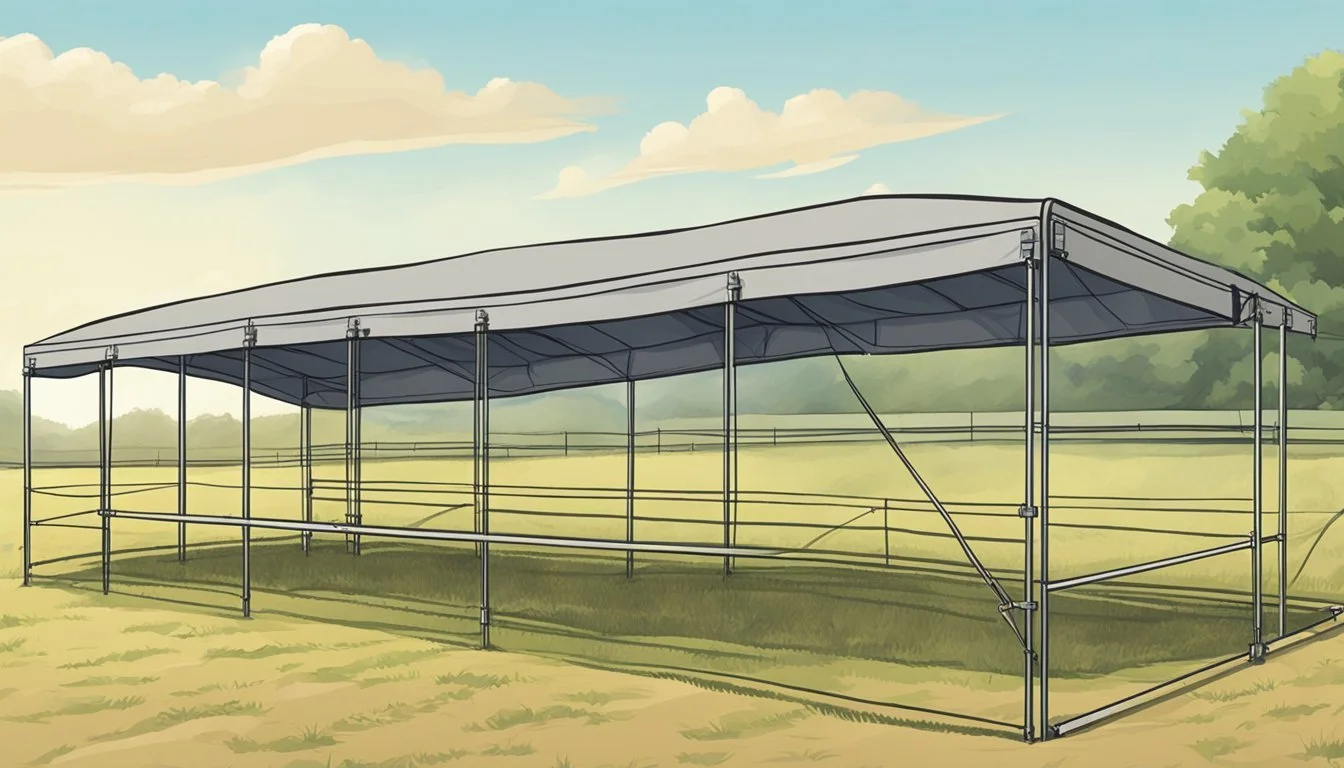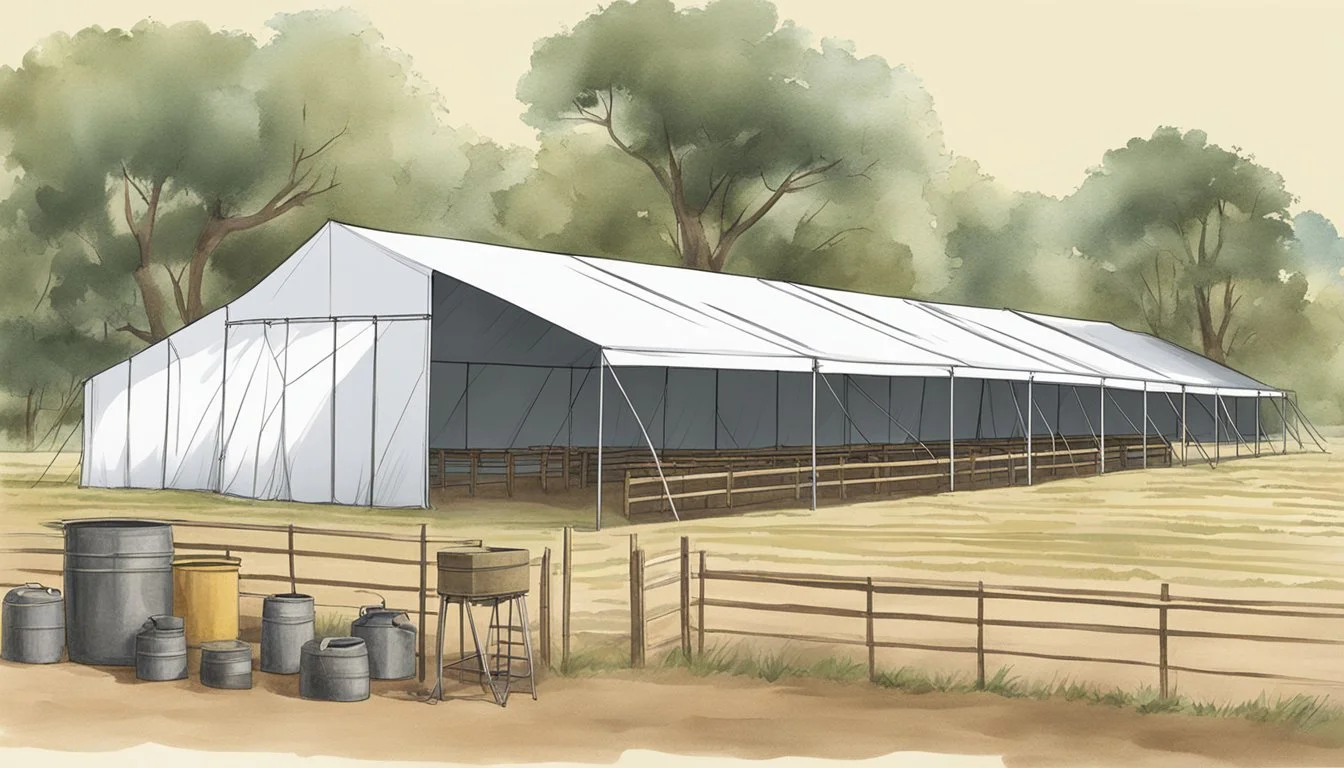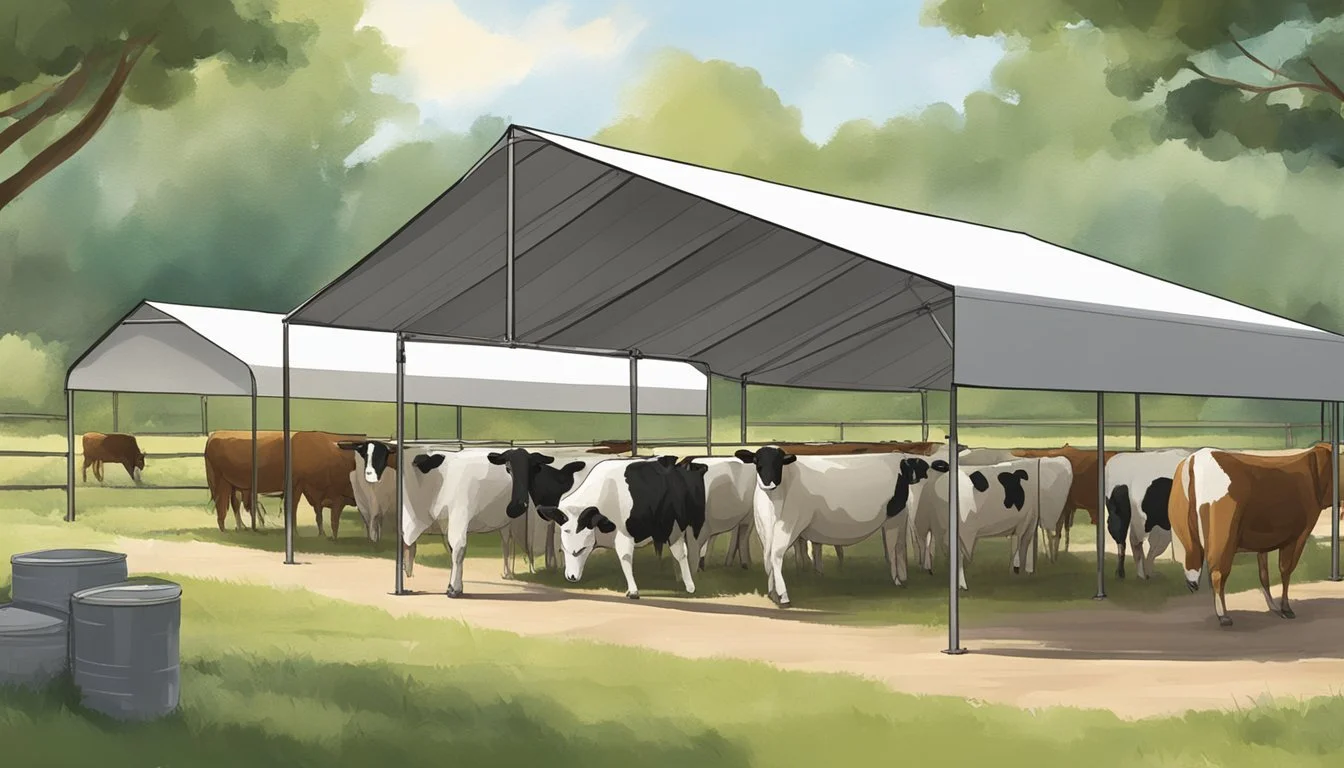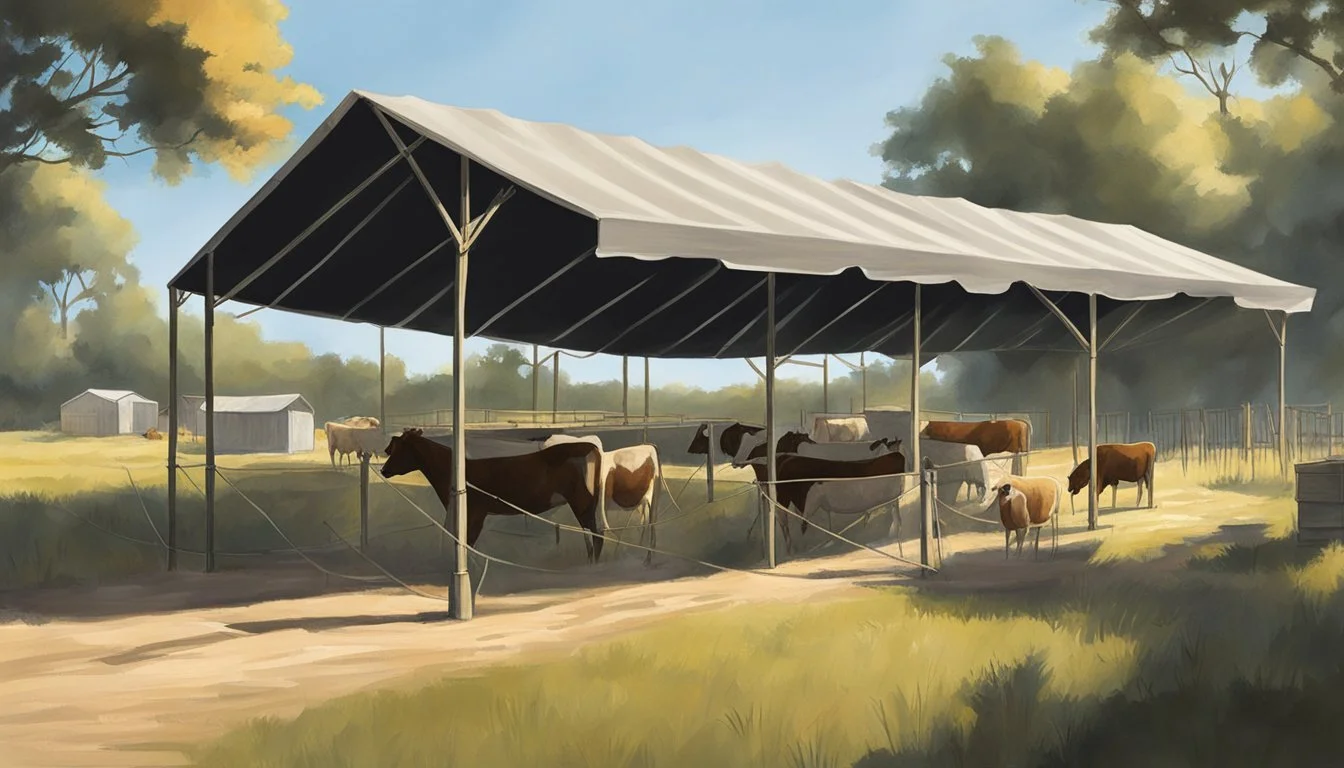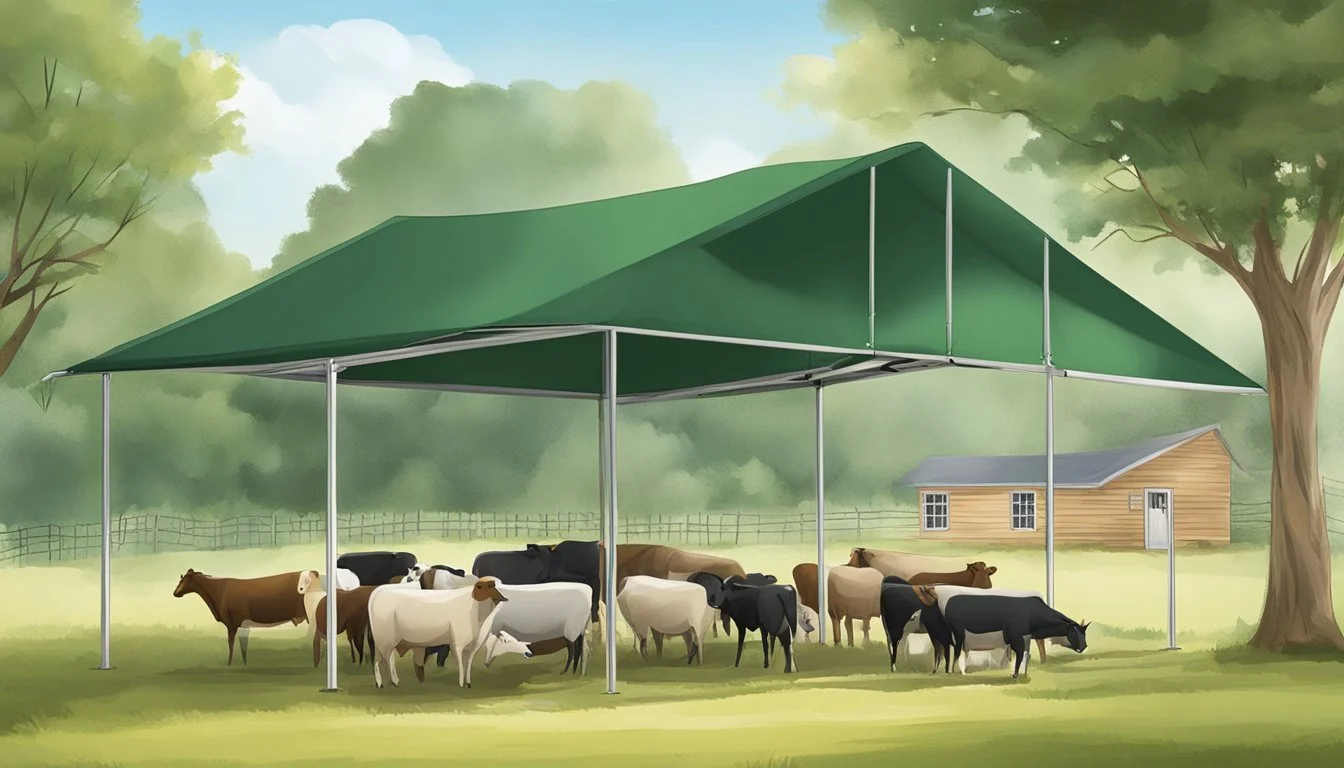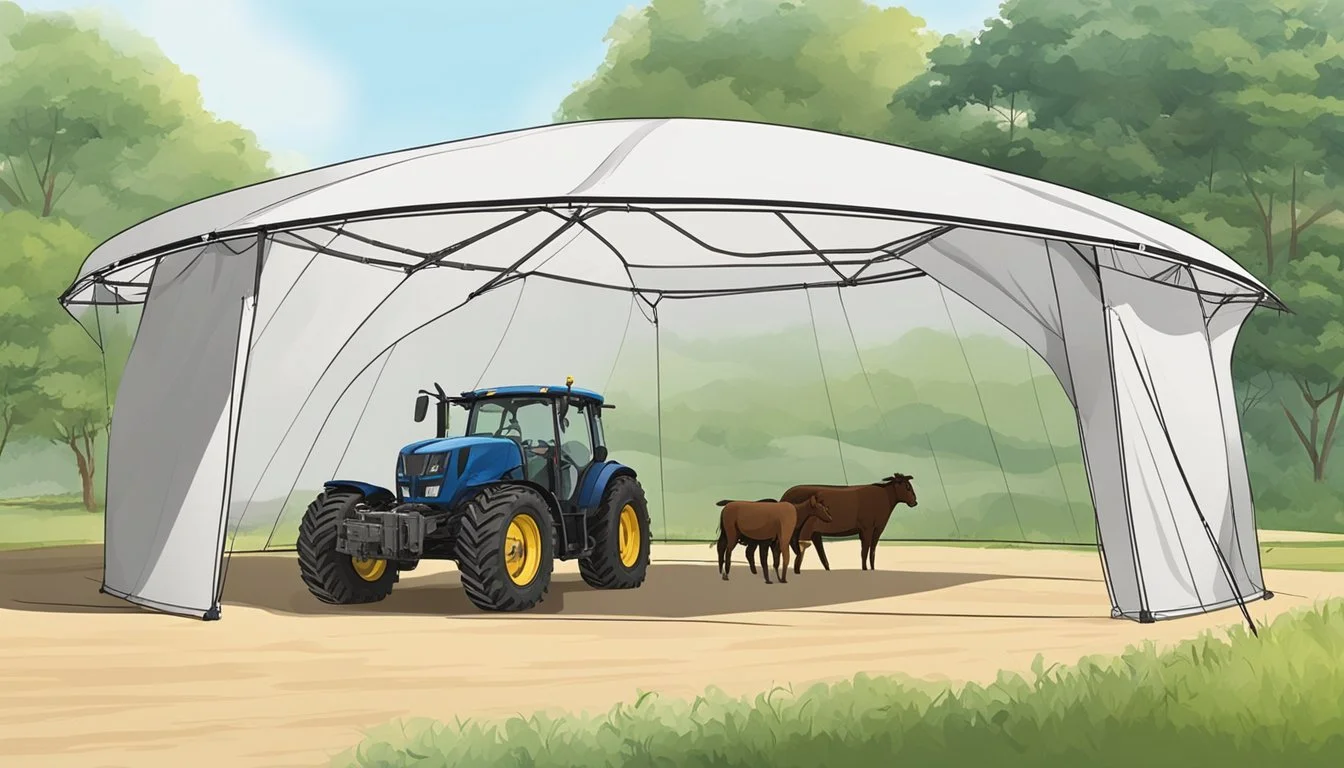Top 5 Portable Shade Canopies for Livestock Protection on Your Homestead
Ultimate Sun Shields for Your Animals
Protecting livestock from harsh sun exposure is a critical aspect of managing a successful homestead. As homesteaders delve into the welfare of their cattle, sheep, or other grazing animals, they often consider portable shade canopies as a practical solution. These structures not only offer relief from the heat for the animals but also contribute to productivity by reducing heat stress. The best designs balance durability, ease of movement, and sufficient coverage to ensure animals can comfortably rest and ruminate.
Recent advancements have introduced various options for portable shade canopies, with features ranging from UV-resistant materials to collapsible frameworks for convenient relocation. Livestock owners can select from a variety of sizes and styles to suit their specific needs and pasture layouts. Some models provide large coverage areas and enhanced airflow, which can be particularly advantageous on topographical high points where breeze availability is maximized.
The market's top offerings share certain attributes: sturdiness to withstand diverse weather conditions, ease of assembly and disassembly, and adaptability for various livestock types. When evaluating products, it is important to consider the size and mobility of the herd, the local climate, and the canopy's compatibility with the homestead's daily operations. The right portable shade structure serves as a valuable investment into the health and efficiency of a livestock operation.
Understanding Livestock Shade and Its Importance
Shade is a critical aspect of managing livestock, especially in regions with hot weather and high humidity. It serves to protect animals from heat stress, which can adversely affect their overall quality of life and productivity. Heat stress can lead to reductions in milk production, slowed daily gain, and even increase the risk of death.
The presence of adequate shade for livestock contributes to the well-being of animals. It offers a cooler environment that can enhance forage intake, reproduction rates, and rate of gain. Specifically, milk production can diminish by up to 1.5 liters per cow during extreme heat conditions.
Utilizing shade cloth and other livestock shade structures is beneficial and contributes to sustainability practices on a farm. These structures can range from natural options like trees to permanent fixtures and portable shade canopies. Portable options offer flexibility and typically require a smaller upfront investment.
Benefits of Livestock Shade:
Reduces heat stress
Increases milk production and daily weight gain
Improves nutrient distribution
Supports sustainable farming practices
Enhances the quality of life for the animals
On the economic front, despite livestock shade structures having associated costs, they often yield a positive return on investment through improved livestock performance. It is clear that providing shade is not only humane but also advantageous for a farm's productivity and ultimately its bottom line.
Top 5 Portable Shade Canopies
Selecting the right portable shade canopy is crucial for safeguarding livestock against the elements. These top picks offer robust protection, ease of setup, and portability to ensure the well-being of cattle, sheep, goats, and other farm animals.
SH1200 Portable Shade Canopy
The SH1200 is designed specifically for graziers seeking maximum protection for their herd. With a heavy-duty steel frame, this canopy is both UV treated and resistant to corrosion, providing an extensive shade area. Its strength and durability make it a solid investment for livestock shade.
Shade Haven Mobile Shade System
Shade Haven offers a premium option with their Mobile Shade System. This innovative product features a portable design and a sturdy frame that is built to last. The system spans a wide area, providing ample shade options for grazing cattle. Easy to transport and set up, it is an ideal artificial shade solution for large pastures.
Collapsible Polypropylene Shade Canopies
These canopies come with a lightweight frame that makes them easy to transport, and the polypropylene material ensures breathability for the animals. Collapsible in nature, they provide an affordable and convenient shade structure for varied livestock needs.
Galvanized Steel Corral Shelter
With a frame made from galvanized steel, this shelter offers rock-solid strength and stability. The galvanized nature of the steel ensures resistance to rust and corrosion, making it a durable choice for cattle owners. Designed for easy assembly, this corral shelter is an efficient way to offer shade in a more permanent pasture setup.
Knitted Polypropylene Shade Structures
Knitted Polypropylene Shade Structures are known for their durability and excellent air flow, which is vital for animal comfort. Their sturdy frames often come with a powder-coated finish to prevent rust. Accompanied by protective boots at the base, these canopies ensure both safety and breathability for a variety of livestock, including sheep, cows, and goats.
Key Specifications to Consider
When choosing a portable shade canopy for livestock, several specifications merit close attention:
Material Durability: The canopies should be constructed from materials that resist wear and tear. Vinyl and mesh covers are common options, providing durability and airflow.
Corrosion and Rust Resistance: Metal components, such as the frame, should be made from corrosion-resistant materials like galvanized steel to enhance longevity and maintain structural integrity.
Shade Area: The size of the shade area is crucial. It should be ample to accommodate the intended number of animals. A standard measure to consider is square feet of shaded space.
Strength and Weather Resilience: Frames must be robust enough to withstand severe weather conditions. Look for canopies that can hold up against high winds and collapsing risks.
Size and Weight: Canopies should be lightweight enough for easy transportation yet stable when erected. Dimensions and weight affect both portability and coverage.
Setup Mechanism: A user-friendly hand crank mechanism for opening or closing the canopy can save time and effort.
Warranty Period: Warranties provide a guarantee of the product’s performance and durability. Always check the warranty period offered by the manufacturer.
Additional Features: Look for extras like grommets that contribute to the canopy's functionality. Grommets can offer points for securing the canopy firmly to the ground or additional supports.
A table formatted overview for quick reference:
Specification
Material
Corrosion Resistance
Shade Area
Strength
Dimensions & Weight
Setup Mechanism
Warranty Period
Additional Features
Importance
High (for all specifications)
Notes
Vinyl/mesh for durability; allows airflow (Material)
Galvanized steel to resist rust (Corrosion Resistance)
Measured in square feet; adjust per livestock size (Shade Area)
Must endure severe weather (Strength)
Balance between coverage area and portability (Dimensions & Weight)
Simple, efficient systems like hand cranks preferred (Setup Mechanism)
Longer warranties indicate confidence in product (Warranty Period)
Grommets and other extras add functionality (Additional Features)
Choosing the right portable shade canopy involves evaluating these key specifications to ensure the protection and comfort of livestock on the homestead.
Comparative Analysis of Shade Systems
Portable shade systems are vital for livestock protection, particularly during warmer months. These shades offer respite for animals, improving their well-being and productivity. In analyzing various shade solutions, durability, ease of transport, and cost-effectiveness are key considerations.
Rush-Co Tailored Covers feature a hand crank mechanism, highlighting ease of use, and are constructed with quality materials designed to endure over time. With bolt-together components, installation is advertised as taking approximately four hours.
Shade Haven's mobile structures boast the ability to move readily across pastures, an essential feature for rotational grazing. Their flagship product, the SH1200, is equipped to provide up to 1,200 square feet of shade.
The SH600 is a more affordable, scaled-down version of the SH1200, suitable for smaller herds. Its heavy-duty steel frame and transportable design make it an attractive proposition for cost-conscious homesteaders seeking quality and portability.
When building a custom portable shade, hobby farmers can tailor specifications to their specific land and livestock needs. For instance, structural steel pipes can serve as sturdy frame materials for a durable shelter, as specified in an article from Hobby Farms.
Lastly, Technomantic emphasizes the importance of safety and maintenance in their analysis of shade canopies. Secure anchoring and proper care are underscored, which are important to consider in the longevity of the investment.
Each system presents a unique set of features that cater to different needs, whether it's the size of the coverage area or ease of assembly. For those seeking to protect their livestock with a reliable, portable shade solution, these options represent a spectrum of price points and functional specifications.
Installation and Maintenance Tips
When selecting portable shade canopies for livestock, it's essential to consider both the setup process and the maintenance required to ensure longevity.
Setup:
Preparation:
Find level ground for stable installation.
Check for overhead and underground utilities.
Assembly:
Follow manufacturer's instructions precisely.
Use bolt-together components to avoid welding, enhancing portability.
Transport:
Ensure the design is collapsible for ease of transport.
Consider the transport length—shorter canopies are easier to move.
Durability:
Look for canopies made from corrosive-resistant materials like galvanized steel.
High-quality materials matter for structural integrity.
Choose canopies with durable vinyl or mesh covers.
Daily Maintenance:
Inspect the structure regularly for wear and tear.
Clean the canopy fabric as recommended to prevent damage.
Long-Term Maintenance:
Span: The longer the span, the more critical routine checks become.
Durability: Periodically replace any weakened parts.
Collapsible: Lubricate moving parts to maintain a smooth folding mechanism.
Transporting Canopies:
Choose models with hand-crank mechanisms to simplify opening and closing.
Check the weight and folding dimensions to ensure easy relocation.
Livestock Productivity:
The quality of the shade structure can directly relate to daily gain in livestock, as proper shade reduces heat stress.
Position the canopy to provide maximum relief during peak sunlight hours.
By adhering to these practical tips, one can ensure their portable shade structures serve effectively and last for years, all while supporting the welfare and productivity of their livestock.
Impact of Shade on Livestock Well-Being
Shade serves as an essential component in managing livestock well-being, particularly in environments where high temperatures are prevalent. Livestock, including cattle, sheep, and horses, experience elevated body temperatures in the absence of shade, leading to heat stress. Providing shade allows these animals respite from direct sunlight, thereby lowering their body temperatures and reducing the risk of heat-related stress or even death.
In cattle, for instance, the presence of shade is linked with lower respiration rates and decreased panting scores, indicating a more comfortable state of being. Notably, shaded animals often display more consistent forage intake, which is vital for maintaining their rate of gain and overall quality of life.
Livestock Type
Cattle
Calves
Sheep
Horses
Impact of Shade
Improved average daily gain (ADG) for Cattle
Higher weight gain for Calves
Better reproduction rates for Sheep
Enhanced overall comfort for Horses
Moreover, studies suggest that the strategic provision of shade can positively affect reproduction rates in livestock such as sheep, subsequently increasing farm productivity. For optimal impact, each animal, like a mature cow, requires ample space, usually around 40 square feet, to ensure access to shade as the sun moves throughout the day.
In terms of calves and young steers, the benefits of shade contribute to better growth patterns, often reflected in improved weight gain and average daily gain (ADG), crucial metrics in livestock production. While measurements can exhibit variability, the correlation between shade and positive livestock outcomes is unmistakable.
Through mitigating heat stress, shade thus maintains healthier and more productive animals, showcasing its pivotal role in effective livestock management.
Economic Benefits and Cost Analysis
Investing in portable shade canopies for livestock is not only a necessity for animal welfare but also presents considerable economic benefits. According to a study referenced in the Florida NRCS Economic Technical Sheet, dairy farms can see an average annual benefit of $6,585 from one livestock shade structure. When considering the average cost of $242, the net annual benefit amounts to $6,343. This translates to a monthly benefit of around $528 over ten years.
The shade structures contribute to the health and productivity of livestock. Biosystems and Agricultural Engineering expert Stephen F. Higgins highlights that animals with adequate shade exhibit better fertility rates, contributing to long-term herd sustainability.
Livestock shaded from intense heat have demonstrated improved average daily gains (ADG). For example, portable shades have led to weight increases in cows by 1.25 lb per day, in calves by 0.41 lb per day, and in steers by 0.89 lb per day. Such gains are pivotal in making these structures a cost-effective investment.
While initial costs may vary, affordability is an advantage, as bolt-together components can often be assembled without professional consultation, reducing setup expenses. In summary, leveraging portable shade for livestock protection yields measurable economic benefits, enhances animal growth performance, and provides a return on investment through improved cost-effectiveness and efficiency.
Additional Considerations for Shade Placement
When selecting the optimal location for portable shade canopies to protect livestock, several key factors warrant careful consideration to ensure the well-being of cattle and the effective use of pasture resources.
Environmental Factors:
Air Circulation: Position shades in areas where they will harness natural breezes, providing cattle with fresh air, which is critical for their health and comfort.
Sun Path: Be mindful of the sun's trajectory and orient the canopy to maximize shade during the hottest parts of the day.
Geographical Considerations:
Elevation: Placing shades on a knoll or elevated ground allows for better air flow and drainage, reducing the likelihood of cattle congregating in wet or muddy conditions.
Paddock Rotation:
Fresh Ground: Regularly move the canopy to avoid soil compaction and to ensure uniform nutrient distribution from cattle across the pastures.
Factor
Environmental
Geographical
Paddock Management
Consideration
Airflow optimization, sun position for maximal shading (Environmental)
Preference for higher ground for drainage, avoidance of low-lying damp areas (Geographical)
Frequent repositioning to distribute grazing and prevent overuse of any one area within the pasture (Paddock Management)
Vegetation Synergy:
Consider the canopy's placement in relation to existing trees and sheds to augment the natural shade and shelters.
By strategically placing portable shade canopies, one can significantly improve the living conditions of their cattle while maintaining the health and sustainability of their pastures. Safeguarding against elements such as wind and sun while providing shelter on fresh ground helps in creating an environment where livestock can thrive.
Product Warranties and Customer Support
When selecting a portable shade canopy for livestock, farmers should consider not only the quality of the product but also the warranty period and the customer support services provided. Warranties are indicative of a manufacturer's confidence in their product and can protect the buyer's investment.
Warranty Period: Typically ranges from one year to limited lifetime warranties. Buyers should confirm the length and terms of the warranty as it can vary significantly between products.
Consultation and Quotes: Manufacturers often offer free consultations and quotes to assist customers in making informed decisions. They may provide an estimation of costs, including any relevant shipping fees.
Customer Support: Reliable customer support is essential. Prospective buyers should look for services such as toll-free numbers or email support to assist with any queries or issues post-purchase.
Quality Products: Reputable companies stand behind their products. A commitment to providing high-quality materials that can withstand the elements is a key tenet of top manufacturers.
Investment Protection: Purchasing a canopy is a significant investment; therefore, understanding the warranty and having access to customer service can help protect against unforeseen issues.
Product Demonstrations (Demos): Some companies may offer demonstrations of how their canopies operate, which can be an invaluable opportunity to see the mechanism like the easy-to-use hand crank systems firsthand.
Customers are advised to check for multilingual support if necessary and inquire about the process for making a warranty claim. Adequate support can greatly enhance the user experience and satisfaction with the product.
Exploring Innovative Shade Solutions
When considering the welfare of livestock, especially in open pastures, providing shade is crucial. It not only improves the animals’ comfort but also contributes to a better microclimate for them to thrive. Innovative shade solutions for cattle grazing have evolved to offer practical and portable options.
Portable Shade Canopies are a game-changer for livestock protection. They can easily be moved across the pasture, ensuring that animals have access to shade as they graze. These structures are often collapsible, making assembly and disassembly straightforward. The framework is typically built with durable materials like galvanized steel, which grants longevity and sturdiness to withstand various weather conditions.
One notable innovation in this space is the Shade Haven. This mobile shade structure creates a substantial shaded area, capable of being relocated as needed. It efficiently addresses the need for artificial shade where natural cover is sparse.
Shade Cloth is another core component. Designed to block specific percentages of sunlight and ultraviolet rays, shade cloths adapt to different shading needs and help to maintain adequate ventilation.
The table below summarizes the benefits of portable shade options:
Feature
Mobility
Collapsible
Sturdy Materials
Shade Cloth
Benefit
Easily create shade where needed (Mobility)
Simple to erect and take down (Collapsible)
Long-lasting use in varying climates (Sturdy Materials)
Customizable sun protection (Shade Cloth)
These technologies represent a commitment to the future of sustainable livestock farming. By investing in portable shade solutions, farmers can enhance their cattle's welfare while also fostering a better microclimate within their pastures.
Final Recommendations and Conclusions
When selecting a portable shade canopy for livestock, durability and ease of use are paramount. A sturdy steel frame and a high-quality shade fabric are ideal features to ensure longevity. Rush-Co Tailored Covers offer such frameworks, with a hand crank mechanism simplifying the processes of opening and closing the canopy.
For smaller herds, a compact and affordable option like the SH600 model from Farm and Livestock provides 600 square feet of coverage and is transportable by standard vehicles, making it a practical choice for herds of 20 to 30 cattle.
Livestock shade not only improves animal welfare but can also enhance productivity by mitigating heat stress. Such effects include improved milk production and weight gain, as well as maintaining regular gestation lengths.
When considering installation, a system that requires minimal assembly time and avoids the need for welding, as highlighted by Rush-Co Tailored Covers, can significantly reduce initial setup challenges.
Investing in a portable shade system requires thoughtful consideration of herd size, mobility needs, and material quality. Prioritizing these aspects will lead to a well-informed decision that benefits both the livestock and the productivity of the homestead.


